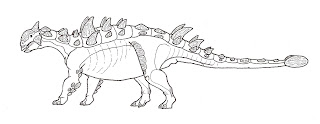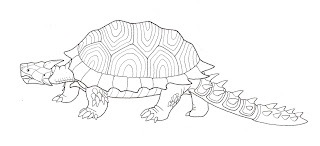
Plenty of animals have evolved natural defenses toward predation and intraspecific combat. You don't need to jump into the Wayback Machine, either, because so many armored creatures are right in front of us: armadillos, pangolins, horney toads, thorny devils, sea urchins, and of course turtles to name a few. However, some animals in Earth's history found it wise to develop a more proactive form of protection: tail clubs. These are most recognizably found on ankylosaurs, like Euoplocephalus (above). Only one group of ankylosaurs (the ankylosaurines) seem to have evolved tail clubs. They are formed from hypertrophied bone scutes that get progressively larger as the animal grows.
Earlier this year, Victoria Arbour found that a full-grown ankylosaur's tail club could easily break the limb bone of an attacking tyrannosaur. This was achieved by virtue of the structure of the ankylosaur tail. Imagine a rod attached to a flexible base with a heavy club at the end. This is easy to model: try swinging a baseball bat with your arms to hit something. Now, try swinging a chain. The bat, being a solid rod, does more damage. The problem, though, is that after enough hits, the structure of the bat breaks down. Ankylosaurs try to solve that problem by reinforcing the caudal rod with interlaced ossified tendons that wrap around the vertebrae. They originate at the sacrum and actually continue underneath the osteoderms of the club. This protects the rod from damage by cushioning the blow and absorbing the impact force. It also strengthens the rod, making it more dangerous!

Millions of years after all the ankylosaurs had gone extinct, xenarthran mammals became the new heavily-armored kids on the block. Glyptodonts are related to sloths and armadillos, and their armor is very distinct. Rather than being formed from a wide range of scutes, spikes, and plates embedded in the skin, glyptodonts enveloped their bodies in tiny, interlocking, hexagonal scutes. While protective, this "coat of mail" allowed limited flexibility for the movement of the limbs beneath it. The head was topped by these same scutes. In many glyptodonts, the tail was protected by a series of ever-smaller scute "rings." The tail itself often ended in a pot-marked club. Experts suggest that conical spines sat in these pot-marks, giving the tail club a mace-like appearance.
What would be more dangerous than getting whacked by the relatively blunt side of an ankylosaur club? Being jabbed by the point of a glyptodont mace, that's what! Blanco, Jones & Rinderknecht found that the largest conical spines originated at the tail club's "center of percussion." That is, the point at which the most damage could be done while avoiding repercussive injury. All the force of a swinging club concentrated at the point of a mace? That could really do some damage! However, rather than attacking predators, the maces may have been used in intraspecific combat, as evidenced by healed carpace fractures in some individuals. Despite gross morphological differences, the tail clubs of ankylosaurs and glyptodonts are built the same: a flexible base wields a strong, infexible rod with a club or mace at its end.
But ankylosaurs and glyptodonts aren't the only animals with tail clubs...

How could we forget about Meiolania, a large Pleistocene turtle from Australia? Meiolania was about as well-protected as turtles come, with large cranial horns, pointed carpace edges, and half-rings of spines on the proximal half of its long tail. The distal third was covered in an extensive bony shell of its own--an inflexible club that was covered with spikes. Unlike ankylosaurs and glyptodonts, Meiolania's caudal vertebrae were not stiffened into a rod, but the half-rings would have limited the tail's lateral mobility. Rather than remark on this turtle's club, I will simply leave you with a question: what on Earth was this turtle defending against?




2 comments:
Meiolania was obviously defending itself from a giant marsupial carnivore version of Shredder.
Really cool illustrations, by the way!
Meiolania probably defended itself from Megalania, mekosuchine crocodiles, Thylacoleo...pretty much anything that tended to tick it off. One doesn't need a badass predator to develop defenses. I mean look at the glyptodonts, all they had to worry about was Thylacosmilus, other borhyaenids, and the terror birds, and yet they developed those clubs.
Some paleontologists have suggested that the club of ankylosaurs was not used in defense or combat, but in interspecies recognition. Yeah...while it seems fairly likely that the secondary structure of such an adaptation could be used for differentiating between species, the anatomical design suggests that the club was used mainly for one thing; beating the crap out of its enemies.
Post a Comment